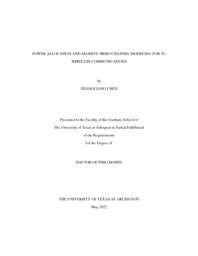| dc.description.abstract | To meet the demand for wireless communication transmission rate to reach a thousand times of the existing system in 2021, the fifth-generation (5G) mobile communication system was developed. Compared with Long-Term Evolution (LTE), the 5G mobile communication needs to be transmitted in wireless breakthrough innovation in technology to achieve the goal of ten times increase in spectrum efficiency and power efficiency. As a time series analysis tool based on vector autoregression, Granger causal analysis originated in the field of econometrics, and its staged generalized transfer entropy (TE) based on conditional co-information in information theory has been widely used in recent years in data analysis field.
Among them, further tapping the spatial multiplexing capability of multiple antennas is a key way to
achieve 5G. Configure large-scale antenna arrays or multiple at the access point are interconnected by optical fibers to establish a large scale distributed Massive Multiple Input Multiple Output (MIMO) system. A significant improvement of the spectrum efficiency can be achieved by implementing the Massive MIMO system. Also, the Massive MIMO channel modeling is necessary both in the theoretical research phase of Massive MIMO as well as in the application phase of the systems. Therefore, Massive
MIMO channel modeling is an important content in the research.
This dissertation investigates the 5G channel forecasting and power allocation, as long as channel modeling by Massive MIMO.
The first part of this dissertation focuses some analysis of 5G channel forecasting and power allocation. Granger Causality has been derived to confirm the relationship between two random 5G channel coefficients. Transfer entropy is proposed to predict channel coefficients, and the accuracy of the prediction is computed by using root mean square error (RMSE) and Cramer-Rao lower bound (CRLB). Furthermore, an Inverse Water Filling (IWF) algorithm is applied to perform the power distribution based on the predicted channels.
The channel modeling for Massive MIMO communications at 28G Hz is mainly presented in the second part. The Indoor and through-wall (TW) Massive MIMO wireless communication scenario is used. We can consider the Line-of-sight (LOS) communication is achieved under indoor scenario and Non-Line-of-sight (NLOS) communication under TW scenario. The center frequency of 28G Hz is used on Transmission side and the actual RF signal is collected. Then, a Space Alternating Generalized
Expectation maximization (SAGE) algorithm is used to extract large-scale parameters to obtain the millimeter wave Urban Micro (UMi) scale parameters and small-scale parameters of the LOS and NLOS of the channel on the basis of the actual channel data. Finally, the departure angle, angle extension of the transmitted signal, arrival angle, angle extension of the received signal, angular power spectrum, Doppler power spectrum and other parameters are used to model the channels.
Third, a forecasted channel system on the basis of LSTM neural network is devised to deal with the problem of gradient disappearance in the Recurrent Neural Network (RNN) specialized in dealing with time series problems. Forecasting was made using 5G channels simulated by the NYU Wireless Communications Simulator. Then, the designed arithmetic is performed and the performances are compared with the real channel, and small RMSE is obtained, which shows the high accuracy of the prediction. After that, based on the channel forecasted by using the LSTM network, the power allocation based on cooperative communication is derived, and compare the power results without cooperative communication. For the single-relay and multi-relay cooperative scenarios, a power allocation schema under the end goal to maximize the information transmission rate (ITR) at the destination node is proposed. The realization process of this scheme is constructing the information transmission rate function of the destination node under the condition of setting the total power transmitted is a fixed value by the node. The objective function can be considered as the optimization of a convex function, which can obtain the optimal solution by the Lagrangian formula. When the ITR of the destination node is the maximum, the source node and relay node achieved the optimal transmission power values. Therefore, system performance is improved by optimizing power allocation method of the transmitting nodes. By comparing with other schemes, it is verified that the power allocation scheme proposed in this dissertation has better performance and saves system resources. | |


